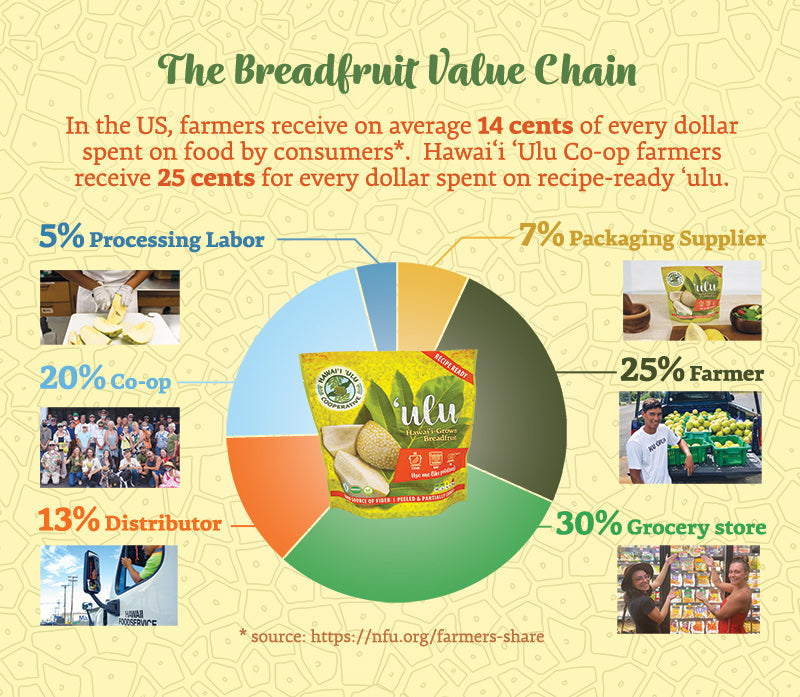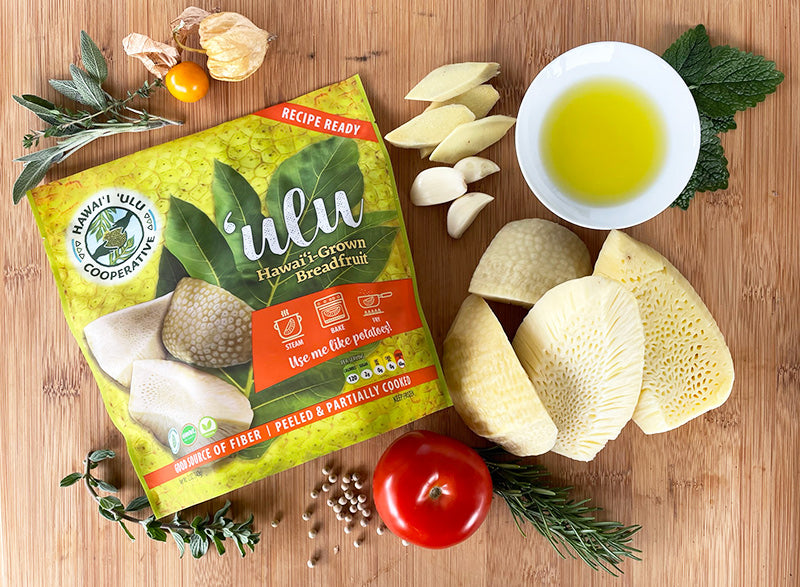The ʻUlu Value Chain in Hawaiʻi

An agricultural value chain refers to the different "links" required to take a product from farm to end consumer. Here is a look at each of the actors who work together to bring our Recipe-Ready ʻUlu to markets across Hawaiʻi, along with their distinct roles and risks.
The Farmer
Role: Contributes high quality fruit; plants and maintains trees. Stewards land regeneratively to ensure sustained production for generations to come.
Risks: Extreme weather, pests and diseases could reduce harvestable crop. Cost of land, water, energy, and labor is among the highest in the world and has a significant affect on farm economic viability.

The Cooperative
Role: Provides technical support to farmers, aggregates fruit to reach economies of scale, provides manufacturing infrastructure to add value to crops, develops markets and educates consumers.
Risks: Provides farmers with a guaranteed market and stable price, regardless of consumer demand. Takes on the risk of fresh fruit spoilage and processing waste. Responsible for fundraising, developing shared infrastructure, food safety certification and market development.

Processing Labor
Role: Employees receive, sort, wash, peel, cut, cook, and package fruit for consumers.
Risks: Physical work entails risk of injury, compounded by crop seasonality which requires long hours during peak production months.

Packaging Supplier
Role: Provides food grade, recyclable packaging to maintain product quality and shelf life in the freezer.
Risks: The cost of materials may increase due to inflation.

Distributor
Role: Provides transport and maintains cold chain from plant to store.
Risk: Cost of transport may increase due to energy prices; responsible for maintaining product temperatures if route is disrupted.

Grocery Store
Role: Makes ʻulu conveniently available year-round to home buyers.
Risk: The store must carry the inventory and pay for cold storage until customer purchase.

Building a strong and vibrant ʻulu value chain in Hawaiʻi
Building a strong and vibrant ʻulu value chain in Hawaiʻi that will sustain farmers and the community for years to come requires partnering with various commercial and community organizations.

In the US, farmers currently receive on average 14 cents of every dollar spent on food by consumers*. Hawaiʻi ʻUlu Co-op farmers receive 25 cents of every dollar spent on our recipe-ready ʻulu packs.**
Fresh ʻulu purchased directly from a farmer's market or through a food hub (like the co-op) typically provides an even higher percentage return for the farmer – around 70 cents of every dollar spent.
However, by minimally processing our farmers’ crop and building economy of scale solutions for a highly perishable, seasonal fruit, we are able to provide a stable market and price for producers while making ʻulu a convenient and accessible staple food for the community year-round.

All value chain stakeholders must receive a sufficient reward for their contribution in order for the partnership to be sustained. Part of our cooperative ethos means recognizing that it's better long-term to work together and increase the size of the whole pie, rather than competing to increase your share of a smaller pie.

One of the most valuable lessons we’ve learned as the first Hawaiʻi member of PIFON, an international farmer network representing 14 countries across Polynesia, is that a farmer-inclusive value chain is a powerful formula for developing sustainable market linkages – not just locally but across the Pacific.
According to PIFON's Value Chain Development Guide, "Innovation in all aspects of the agri-food system, including in how producers organize themselves to address challenges, is critical to meet our shared goals of food security throughout the region."
To foster the transition towards a more resilient food system that provides sustainable incomes and enhances the health and wellbeing of communities, we need empowered farmers and producer organizations.

It takes many hands working together – including yours! – to build a strong, regenerative value chain, especially when it comes to revitalizing an indigenous staple crop. When you choose to incorporate ‘ulu in any form into your diet, you’re contributing to a local food economy where a greater share of the purchasing dollar goes back to Hawai‘i farmers.


Leave a comment
Please note, comments must be approved before they are published